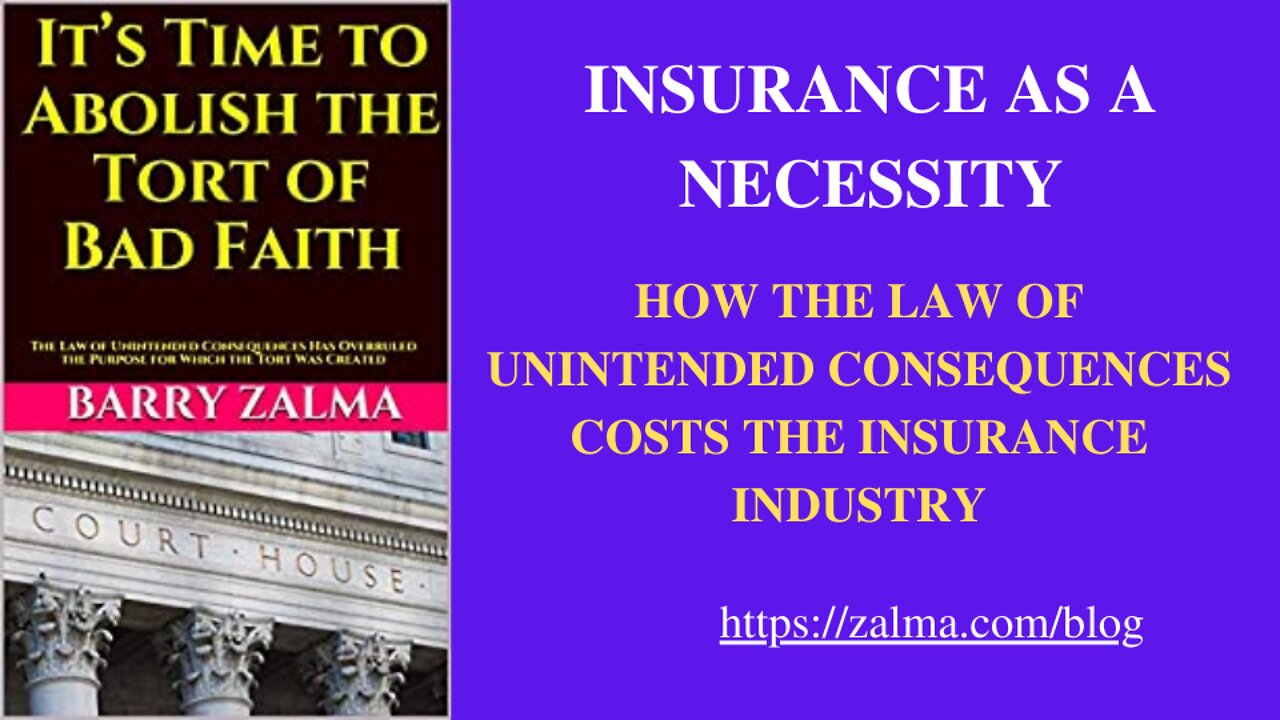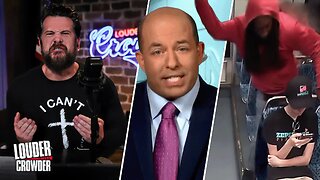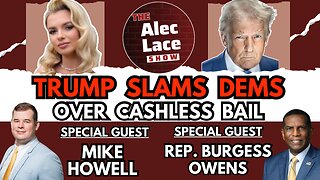Premium Only Content

INSURANCE AS A NECESSITY
HOW THE LAW OF UNINTENDED CONSEQUENCES COSTS THE INSURANCE INDUSTRY
Neither the courts nor the governmental agencies seem to be aware that in a modern, capitalistic society, insurance is a necessity. No prudent person would take the risk of starting a business, buying a home, or driving a car without insurance. The risk of losing everything would be too great. By using insurance to spread the risk, taking the risk to start a business, buy a home, or drive a car becomes possible.
Insurance has existed since a group of Sumerian farmers, more than 5,000 years ago, scratched an agreement on a clay tablet that if one of their number lost his crop to storms, the others would pay part of their earnings to the one damaged. Over the eons, insurance has become more sophisticated, but the deal is essentially the same. An insurer, whether an individual or a corporate entity, takes contributions (premiums) from many and holds the money to pay those few who lose their property from some calamity, like fire. The agreement, a written contract to pay indemnity to another in case a certain problem, calamity, or damage that is fortuitous, that is that occurs by accident, is called insurance.
In a modern industrial society, almost everyone is involved in or with the business of insurance. They insure against the risk of becoming ill, losing a car in an accident, losing business due to fire, becoming disabled, losing their life, losing a home due to flood or earthquake, or being sued for accidentally causing injury to another. The insurers, insureds, or people damaged by those insured are dependent on one another.
In a country where human interactions are governed solely by the terms of written contracts, insurance would be a simple means of spreading risk and providing indemnity based on the promises made by the contract of insurance. But, in this the real world, insurance contracts are controlled by statutes enacted to ostensibly protect the consumer of insurance, regulations imposing obligations on the conduct of insurers and the decisions of trial and appellate courts interpreting insurance contracts.
A simple insurance contract between two parties might say: “I insure you against the risk of loss of your engagement ring valued at $15,000 by all risks of direct physical loss except wear and tear for a premium paid by you of $15.00.” Anyone who could read would understand that contract. If something happens to damage, destroy or lose the ring the insurer will pay you $15,000.00. However, insurers cannot write such a simple contract because the state requires many terms and conditions that complicate the policy wording and confuse the common person. The states and courts that did so had nothing but good intentions to protect the consumer against the insurer and control the actions of the insurer.
EXAMPLES OF UNINTENDED CONSEQUENCES & INSURANCE
Simplified Wording Causes Ambiguity
Insurance contracts can be simple or exceedingly complex, depending on the risks taken on by the insurer. Regardless, insurance is neither more nor less than a contract whose terms are agreed to by the parties to the contract. Over the last few centuries, almost every word and phrase used in insurance contracts have been interpreted and applied by one court or another. Ambiguity in contract language became certain. However, the average person saw the insurance contract as incomprehensible and impossible to understand.
Courts, struggling to understand policies of insurance added to the concern of Legislators:
As said in Insurance Company of North America v. Electronic
Purification Company, 67 Cal. 2d 679, 689, 63 Cal. Rptr. 382, 433 (1967), the insurance company gave the insured coverage in relatively simple language easily understood by the common man in the marketplace, but attempted to take away a portion of this same coverage in paragraphs and language which even a lawyer, be he from Philadelphia or Bungy, would find difficult to comprehend. [Hays v. Pacific Indemnity Group,8 Cal. App. 3d. 158, 80 Cal. Rptr. 815 (1970).]
Ostensibly to protect the public, to salve the concerns of jurists like the one quoted above, insurance regulators and Legislatures decided to require that insurers write their policies in "easy to read" language. Because they were required to do so by law, the insurers changed the words in their contracts into language that people with a fourth-grade education could understand. Precise language interpreted by hundreds of years of court decisions was disposed of and replaced with imprecise, easy to read language. For examples of the “easy to read” or “plain English statutes” go to Appendix 1.
The law of unintended consequences came into play. Instead of protecting the consumer, the imprecise language resulted in thousands of lawsuits determined to impose penalties on insurers for attempting to enforce ambiguous "easy to read" language. The lawsuits cost insurers and their insureds millions of dollars to get court opinions that interpret the language and reword their "easy to read" policies to comply with the court decisions. For more than 30 years, the law of unintended consequences struck the insurance industry that found that a law designed to avoid litigation resulted in exactly the opposite.
The attempts by the regulators and courts to control insurers and protect consumers were made with the best of intentions. The judges and regulators found it necessary to protect the innocent against what they perceived to be rich and powerful insurers. Unfortunately, the plain English statutes had the opposite effect. But, of course, even after it became clear that easy to read policies cause more problems than they cure, the laws and regulations have not been changed.
Bad Faith Causes Bad Behavior
In the 1950s, the California Supreme Court created a tort new to the pantheon of U.S. jurisprudence: the tort of bad faith.
A tort is a civil wrong from which one person can receive damages from another for multiple injuries to person or property. The tort of bad faith was created because an insurer failed to treat an insured fairly, and the court felt that the traditional contract damages were insufficient to properly compensate the insured. The court allowed the insured to receive, in addition to the contract damages that the insured was entitled to receive under the contract had the insurer treated the insured fairly, damages for emotional distress and punitive damages to punish the insurer for its wrongful acts.
Insureds, lawyers for insureds, regulators, and courts across the United States cheered the action of the California Supreme Court, for providing a fair remedy to abused insureds. Most of the states emulated the California Supreme Court and adopted the tort created by the California Supreme Court either by statute or court decision.
The insurers who treated their insureds badly, in fact, profited since they continued their wrongful acts and only were required to pay the few insureds that sued. Those that did not sue added to the wrongdoing insurers profit margins. Honest insurers paid frauds and claims they did not owe and found they needed to raise premium charges to cover the extra expense. The increased premium paid by insureds to cover the extra expense were a clear example of the effect of the law of unintended consequences. The honest insurers who treated those they insured with good faith and fair dealing who paid off fraudsters and paid uncovered claims to avoid bad faith suits needed to charge more than the bad faith insurers who litigated with their insureds.
The law of unintended consequences struck the insurance industry and the insurance buying public. Rather than deter wrongful actions by application of the tort of bad faith, the law of unintended consequences resulted in punishing the honest and correct insurers, honoring the insurers who acted in bad faith with profit, and allowed many frauds to succeed.
Get my Book It’s Time to Abolish The Tort of Bad Faith
Available as a paperback here. Available as a Kindle book here.
(c) 2022 Barry Zalma & ClaimSchool, Inc.
Barry Zalma, Esq., CFE, now limits his practice to service as an insurance consultant specializing in insurance coverage, insurance claims handling, insurance bad faith and insurance fraud almost equally for insurers and policyholders. He practiced law in California for more than 44 years as an insurance coverage and claims handling lawyer and more than 54 years in the insurance business. He is available at http://www.zalma.com and zalma@zalma.com.
Subscribe to Zalma on Insurance at locals.com https://zalmaoninsurance.local.com/subscribe.
Subscribe to Excellence in Claims Handling at https://barryzalma.substack.com/welcome.
Write to Mr. Zalma at zalma@zalma.com; http://www.zalma.com; http://zalma.com/blog; daily articles are published at https://zalma.substack.com. Go to the podcast Zalma On Insurance at https://anchor.fm/barry-zalma; Follow Mr. Zalma on Twitter at https://twitter.com/bzalma; Go to Barry Zalma videos at Rumble.com at https://rumble.com/c/c-262921; Go to Barry Zalma on YouTube- https://www.youtube.com/channel/UCysiZklEtxZsSF9DfC0Expg; Go to the Insurance Claims Library – https://zalma.com/blog/insurance-claims-library/
-
 7:40
7:40
Barry Zalma, Inc. on Insurance Law
1 year agoLoss of Inventory by Bankruptcy
184 -
 1:05:32
1:05:32
Timcast
1 hour agoNepal's Government COLLAPSES, Gen Z REVOLUTION Over Social Media Ban, 19 Dead
38.2K23 -
 2:06:23
2:06:23
Steven Crowder
4 hours agoBrian Stelter's Delusional Response to the Charlotte Stabbing is Everything Wrong With Media
167K178 -
 LIVE
LIVE
The Mel K Show
1 hour agoMORNINGS WITH MEL K - Suicidal Empathy, Denial of Truth & Rewriting History as a Weapon 9-9-25
516 watching -
 DVR
DVR
Clownfish TV
1 hour agoXbox Game Pass Fail! Paranormal Chum Bucket, More! | DREZZED News Live
102 -
 LIVE
LIVE
IrishBreakdown
1 hour agoNotre Dame vs Texas A&M Preview - Irish Must Show Grit In Home Opener
69 watching -
 LIVE
LIVE
Rebel News
43 minutes agoPoilievre on housing crisis, Eby backs ending TFWP, Media mocks Alberta 'book ban' | Rebel Roundup
234 watching -
 LIVE
LIVE
TheAlecLaceShow
1 hour agoGuests: Rep. Burgess Owens, Mike Howell | Trump Condemns Ukraine Refugee Murder | The Alec Lace Show
95 watching -
 59:03
59:03
The Rubin Report
2 hours agoCharlie Kirk Notices Something in the Charlotte Stabbing That Most Are Afraid to Admit
17.1K56 -
 2:03:56
2:03:56
Benny Johnson
3 hours agoBOMBSHELL: Massive Judicial Corruption Scam That ALLOWED Black Killer to Murder in Charlotte EXPOSED
35.3K58